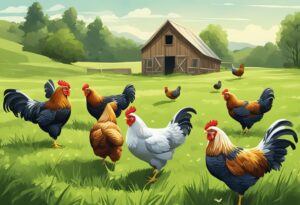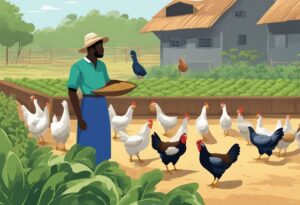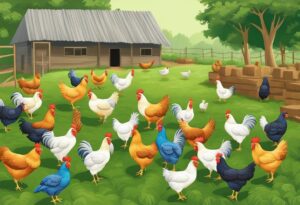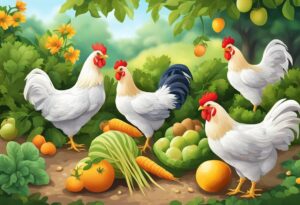Seasonal feeding strategies for layers in Ghana are essential to maintain egg production and hen health throughout the year. The changing climate and availability of feed ingredients affect the hens’ nutritional needs. Adapting layer diets to seasons helps farmers keep their flocks productive by matching feed composition with the hens’ requirements during hot, wet, and dry periods.
Hens need diets that support hydration and shell quality during hotter months, while energy demands may be higher in cooler seasons. Using locally available feed materials and adjusting feeding times can improve nutrient intake and reduce costs. Proper feed storage and water supply management are also key in supporting layers annually.

Understanding these seasonal changes allows farmers to plan feed formulations that safeguard the hens’ health and optimise egg output. Effective strategies reduce waste, improve economics, and enhance the overall sustainability of poultry production in Ghana.
Key Takeaways
- Seasonal changes affect the nutritional needs of laying hens.
- Using local feed sources and proper storage improves feeding efficiency.
- Adjusting feeding practices helps maintain hen health and egg production.
Understanding Seasonal Changes in Ghana

Ghana’s climate varies mainly between wet and dry seasons. These changes affect temperature, humidity, and rainfall patterns, which in turn influence layer chickens’ health, behaviour, and nutrition. Feed supply also shifts with the seasons, presenting specific challenges for farmers.
Overview of Ghanaian Climate
Ghana has two main seasons: a wet season from April to October and a dry season from November to March. The wet season brings heavy rainfall, cooler temperatures, and higher humidity. High temperatures and low humidity characterise the dry season.
Southern Ghana experiences more consistent rainfall, while the northern regions have a shorter wet season and a longer dry season. These climate differences affect crop growth and feed resources. The dry season often leads to reduced fodder availability and poorer ground conditions for farming.
Impact on Layer Physiology
Layers are sensitive to changes in temperature and humidity. High heat during the dry season stresses birds, reducing egg production and feed intake. Cold and damp conditions in the wet season may lower bird immunity and increase disease risk.
Fluctuations in climate also affect water consumption. Layers drink more during hot periods, making the water supply crucial. Proper ventilation and shelter help manage stress caused by seasonal shifts.
Challenges of Feed Availability
Feed availability varies sharply with seasons. During the wet season, crop residues and forage increase, improving feed diversity. In contrast, the dry season limits feed crops, forcing farmers to rely on stored feed or imported supplements.
Due to scarcity, feed costs tend to rise in the dry season. Poor storage can cause nutrient loss and spoilage. Farmers must plan feed storage well to maintain layer nutrition year-round.
More about seasonality and nutrition-sensitive farming in Northern Ghana can be found here.
Nutritional Requirements for Layers

Layers need a balanced diet that supports strong egg production and good health. Their nutritional needs include protein, energy, vitamins, and minerals. These requirements change depending on the season, affecting how much and what type of feed they consume.
Essential Nutrients for Egg Production
Protein is key for egg white and yolk formation. Layers require around 16-18% protein in their diet. Too little protein can reduce egg size and number.
Energy comes mainly from carbohydrates and fats. Energy helps maintain body weight and supports egg-laying. Layers need about 2800-2900 kcal/kg of feed.
Calcium is crucial for strong eggshells. Layers usually require 3-4% calcium in their diet. Phosphorus works with calcium to build bones and shells.
Vitamins A, D3, and E help with growth, shell quality, and immunity. Minerals such as magnesium, sodium, and manganese are also essential in small amounts.
Varying Nutrient Needs by Season
In Ghana, hot and humid seasons affect feed intake. Layers eat less during hotter months, so feed must be more nutrient-dense.
During cooler or rainy seasons, layers eat more. This allows for diets with lower nutrient concentration but more significant quantities.
Seasonal changes also influence calcium needs. Higher temperatures can reduce calcium absorption, so that supplements may be needed in hot months.
Adjusting protein levels based on seasonal intake helps maintain egg production. Feeding strategies considering temperature and humidity improve layer performance in Ghana’s climate.
For detailed information about the effects of feed and temperature on birds, see feeding advice at The Poultry Site or management tips for tropical conditions from Lohmann Breeders.
Formulating Seasonal Diets

Seasonal changes in Ghana affect feed ingredients’ availability and layer chickens’ nutritional needs. Proper diet formulation must consider these factors to maintain bird health and productivity throughout the year.
Diet Adjustments During Dry Season
Feed ingredients like fresh forage and green plants become scarce in the dry season. Layers need diets higher in energy to cope with heat stress and reduced water availability.
Farmers should increase the use of agro-industrial by-products such as wheat bran, rice bran, and maize bran. These provide fibre and energy without adding high moisture content. Adding brewers’ spent grains can improve protein supply.
Supplementing with vitamins, especially A, D, and E, supports bird immunity during these stressful conditions. Proper hydration and electrolyte balance are also critical.
A simple formula adjustment example for dry season feed:
| Ingredient | Percentage (%) |
| Maise | 50 |
| Wheat bran | 20 |
| Rice bran | 10 |
| Brewer’s spent grains | 10 |
| Protein supplement | 7 |
| Vitamin/mineral mix | 3 |
Feeding layers with these components helps sustain egg production when natural feed sources are limited.
Diet Planning for Rainy Season
Green plants and grains are more readily available during the rainy season. Layers benefit from diets that use these fresh, nutrient-rich ingredients to improve overall nutrition.
Farmers can reduce reliance on expensive supplements by incorporating fresh forage and crop residues like cocoa pod husks. These provide fibre and minerals necessary for digestion and egg quality.
Due to cooler temperatures, energy needs may be lower, so diets can have slightly less maise and more protein sources to support growth and laying. Seasonal grains such as maize and sorghum are more abundant and affordable.
Layer diets in the rainy season might look like this:
| Ingredient | Percentage (%) |
| Maise | 40 |
| Wheat bran | 15 |
| Rice bran | 10 |
| Cocoa pod husks | 15 |
| Protein supplement | 15 |
| Vitamin/mineral mix | 5 |
Using local ingredients wisely reduces costs while maintaining good egg production during the wet months.
For more details on using agro-industrial by-products in layers’ diets, see Development of feed package for layers using low-energy agro-industrial by-products.
Locally Sourced Feed Ingredients

Choosing the right ingredients for poultry feed helps control costs and supports local farmers. Some feed components are more sustainable and widely available in Ghana, which plays a significant role in feeding layers throughout the year.
Identifying Sustainable Feed Alternatives
In Ghana, maize is a staple poultry feed ingredient, usually in white or yellow varieties. It provides energy and is often mixed with protein sources like soybeans and fishmeal. These ingredients are preferred because they balance cost and nutrition well.
Local alternatives such as cassava peelings, groundnut cake, or oilseed cakes can reduce reliance on imported feeds. These by-products from farming and food processing provide fibre and protein. Using them sustainably helps minimise waste and supports local economies.
Suppliers often combine these ingredients with mineral supplements like limestone and salt to meet the calcium needs of layers. This combination ensures layers get enough nutrients to produce eggs consistently without significantly increasing feed costs.
Seasonal Availability of Feed Resources
Feed ingredient availability in Ghana changes with the seasons. Maize harvest peaks in the primary cropping season, so prices drop and quality improves at these times. During off-seasons, feed makers rely more on stored stocks or alternative grains.
Soybean and fishmeal supply can vary, depending on local fishing and farming outputs. The rainy season often boosts crop production and ingredients like maize and groundnuts. However, drying and storage limitations sometimes restrict access during this period.
Farmers and feed producers must plan. They often stockpile or buy in bulk before shortages drive prices up. Understanding these seasonal patterns helps maintain a constant feed supply at stable layer prices.
For more details on local feed options, see the poultry feed analysis from WUR eDepot.
Feed Storage and Preservation
Feed storage is essential to keeping layers healthy and productive throughout the year. It helps maintain the feed’s nutritional value and prevents losses due to spoilage or pests.
Best Practices for Preventing Spoilage
Feed should be stored in clean, dry, and well-ventilated areas away from direct sunlight. Moisture is the leading cause of spoilage, so farmers must ensure that feed is fully dry before storage.
Using airtight containers or sealed sacks can protect feed from pests and mould. Regular inspection of stored feed helps detect early signs of spoilage or pests.
Removing old or damp feed before adding new stock reduces contamination risks. If possible, rotating stock using older feed first prevents long-term storage, which can lower feed quality.
Managing Feed Under Humid Conditions
High humidity raises the risk of mould growth and nutrient loss in feed. In Ghana’s humid regions, using raised platforms or pallets to keep feed off the ground helps reduce moisture absorption.
Covering feed with tarpaulins or plastic sheets can protect it from rain and dampness. Adding natural preservatives or drying agents to feed can slow spoilage, but these should be used carefully to avoid harming the birds.
Monitoring temperature and humidity in storage areas is essential for early action. Good airflow reduces condensation and keeps feed dry for more extended periods.
For more details about feed storage practices in Ghana, see feed preservation techniques in ruminant feed resources in Ghana.
Water Management Strategies
Water is essential for layers to stay healthy and produce well. In Ghana, water availability changes with the seasons, so good management is needed to support poultry farming year-round.
Farmers can harvest rainwater during the rainy season and store it in dry months when water is scarce.
Another critical method is groundwater use. Many farmers rely on wells to access underground water for irrigation and poultry needs. Local knowledge helps find and manage these resources effectively.
Efficient water use is key. This includes checking water containers regularly to avoid leaks and providing water in shaded areas to keep cool. Clean water supplies reduce the risk of disease.
Farmers often combine several approaches for better results. These include:
- Collecting rainwater in tanks and ponds
- Using drip or precision watering systems to reduce waste
- Integrating water management with crop irrigation for mixed farming systems
This approach improves water availability and supports layers through the dry and rainy seasons. Adopting these techniques helps increase resilience to climate change. For more on water management challenges and strategies in West Africa, see this agricultural water management resource.
Monitoring Layer Health and Performance
Maintaining good health and steady egg production in layers requires careful observation and detailed record-keeping. Regular checks help identify any changes in laying patterns or signs of nutritional problems early, preventing significant losses.
Evaluating Egg Production Trends
Tracking egg production involves noting daily or weekly egg counts per bird. Sudden egg numbers or shell quality drops can signal health or feed issues.
Producers should record:
- Total eggs laid
- Egg size and shell condition
- Frequency of abnormal eggs
This data helps spot problems early. For example, a steady decline over several days may indicate illness, stress, or poor diet.
Comparing egg production across seasons assists in planning. In Ghana, lay rates may drop during hotter months or feed shortages. Adjusting feeding strategies based on these trends supports better performance.
Detecting Nutrient Deficiencies
Nutrient shortages affect egg quality and bird health. Signs can be subtle but should not be ignored.
Common symptoms include:
- Pale combs or wattles
- Feather loss or poor feather quality
- Soft or thin eggshells
- Reduced egg size or production
Regularly analysing feed and monitoring bird appearance helps identify missing nutrients like calcium, protein, or vitamins.
Direct-fed microbials can improve nutrient absorption and bird health. Monitoring physical signs and egg quality guides timely adjustments in diet and supplements to maintain strong layers.
For more on feed challenges and nutrition, see research on nutrition-sensitive farming in Northern Ghana.
Economic Considerations for Layer Farmers
Layer farmers in Ghana face several economic challenges that directly affect their profitability. Feed is the most considerable expense, making up a significant portion of total production costs. Managing feed efficiently can improve profit margins.
Labour costs also impact earnings. Many farmers spend much on labour, which can reduce overall profits if not managed well. Finding the right balance between labour input and productivity is essential.
Farmers must consider seasonal fluctuations. During certain seasons, feed prices may rise, and egg production can decline due to changes in temperature and daylight hours. Adjusting feed formulation during these times helps maintain egg yields and controls costs.
| Economic Factor | Impact on Profitability |
| Feed Cost | Highest cost; affects overall profit. |
| Labour | Significant expense; needs optimisation |
| Seasonal Changes | Affect feed cost and production levels. |
Farmers may also benefit from vertical integration by controlling more parts of the supply chain. This can reduce costs related to purchasing inputs and selling eggs.
Understanding these economic factors helps layer farmers make better decisions to protect their income. For deeper insights on the impact of feed and labour cost, see the study on the profit efficiency of layer production.
Future Trends in Poultry Nutrition in Ghana
Poultry nutrition in Ghana is shifting towards more sustainable and cost-effective feed solutions. Increased demand for healthier protein sources drives innovation in feed formulation, and producers are looking for ways to balance nutrition with affordability.
One key trend is the growing use of local feed ingredients like maize and cassava. These reduce reliance on expensive imports and support local farmers. They also help tailor diets to seasonal availability, improving feed consistency throughout the year.
Another significant development is the focus on precision feeding. Farmers use bird growth and health data to adjust feed composition more accurately. This can improve feed efficiency and reduce waste.
There is also increased interest in alternative protein sources, such as insect meal and plant-based proteins. These options can lower costs, provide essential nutrients, and reduce environmental impact.
Feed manufacturers in Ghana are adapting by producing more specialised feeds. For example, there is a noticeable shift towards layer feed due to changes in broiler production.
| Future Trend | Benefits | Challenges |
| Local feed ingredients | Lower cost, supports the local economy | Seasonal supply variations |
| Precision feeding | Better feed efficiency, reduced waste | Requires technology and training |
| Alternative proteins | Sustainable, nutrient-rich | Availability and acceptance |
| Specialised feed products | Meets specific bird needs | Market adaptation |
These trends reflect a move to modernise poultry nutrition in Ghana while addressing economic and environmental challenges.
Frequently Asked Questions
Egg-laying chickens in Ghana require changes based on the season. Adjusting nutrients, managing feed quality, and responding to temperature shifts are key to keeping hens healthy and productive all year.
What dietary adjustments are recommended for layer chickens during the humid season in Ghana?
During the humid season, layers need diets that reduce the risk of mould and spoilage. Farmers should provide feeds with lower moisture content and include antioxidants to support health.
Increased energy and protein levels help layers cope with stress caused by humidity. This supports steady egg production.
How should feed rations be altered to meet the nutritional needs of layers in the dry season?
In the dry season, layers often need more water-rich feeds to prevent dehydration. Feed rations may include green fodder or fresh vegetables to supply extra moisture.
Nutrient density can be lowered slightly since chickens are less stressed by heat. However, maintaining a balance of minerals and vitamins is essential.
What is the impact of seasonal temperature variations on the feeding regimen of layer poultry?
High temperatures in the hot season reduce feed intake. Layers eat less but need diets richer in energy and protein to maintain production.
Lower temperatures in cooler months increase feed consumption. Adjusting rations to avoid excess fat gain during this time is essential.
Are there specific feed additives that benefit layers’ productivity during peak heat periods?
Electrolytes and vitamins, especially vitamin C, help birds manage heat stress. Adding probiotics can improve digestion and nutrient absorption.
These additives support immune function and keep egg production stable in hot conditions.
How can farmers ensure a balanced diet for layers while dealing with seasonal changes in feed availability?
Farmers should use feed concentrates alongside locally available feedstuffs to maintain nutrient balance. Proper storage reduces spoilage during humid periods.
Regular feed analysis helps adjust rations based on nutrient content, ensuring layers get what they need year-round.
What strategies can maintain consistent egg production in layers throughout the varying seasons?
Starting with proper rearing and managing environmental conditions supports long laying cycles. Consistent feeding times and quality feed improve laying persistency.
Completing feeds or concentrates designed for layers optimises nutrition regardless of seasonal changes.
